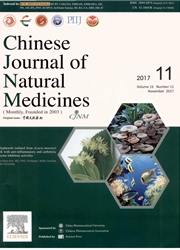

 中文摘要:
中文摘要:
目的:研究不同的羟基红花黄色素A(HSYA)剂型对HSYA代谢、排泄、生物利用度的影响。方法:大鼠灌胃给予HSYA脂质制剂和水溶液,采用HPLC及LC-MS检测血浆、胆汁、粪便、尿液样品。结果:大鼠灌胃给予HSYA脂质制剂和水溶液后,在大鼠胆汁中均发现HSYA及其II相代谢产物;HSYA原药的质荷比为611,而两个II相代谢产物的质荷比分别为918和691,结合酶降解实验表明这两个代谢产物分别为HSYA的谷胱甘肽结合物和硫酸酯结合物。但是同水溶液相比,HSYA脂质制剂显著性降低了HSYA及其II相代谢产物从胆汁的排泄量。大鼠灌胃给予HSYA脂质制剂后,HSYA原药从胆汁、粪便、尿液中24h的累积排泄量分别为(0.05±0.03)%、(8.80±2.30)%、(37.99±17.50)%,其cmax、AUC0-8h分别为2.79μg·mL^-1、402.51μg·min·mL^-1;而大鼠灌胃给予HSYA水溶液后,HSYA原药从胆汁、粪便、尿液中24h的累积排泄量分别为(0.32±0.22)%、(44.66±8.00)%、(5.58±1.30)%,其cmax、AUC0-8h分别为0.08μg·mL^-1、10.73μg·min·mL^-1。结论:实验结果表明脂质制剂可能不会改变HSYA的代谢机制,但是显著性降低了HSYA从粪便和胆汁的排泄量,提高了其生物利用度。
 英文摘要:
英文摘要:
AIM:To characterize the effect of different oral formulations on the metabolism,excretion and bioavailability of hydroxysafflor yellow A(HSYA).METHODS:HSYA lipid-based formulation and aqueous solution were prepared and orally administered to rats.A gradient HPLC and LC-MS method was performed to determine HSYA concentration in rat serum,bile,urine and feces samples.RESULTS:The bile sample digestion test combining HPLC with LC-MS proved the existence of HSYA and phase II metabolites in bile for both formulations.Their protonated molecular ions at m/z 918 and m/z 691 indicated that the metabolites were glutathione and sulfate conjugate,according to the protonated molecular ions of HSYA at m/z 611.The amount of the two metabolites and HSYA excreted from bile was significantly decreased for the lipid-based formulation,compared with that of the aqueous solution.The amount of parent component,HSYA,in bile,feces and urine in 24 h was(0.05 ± 0.03)%,(8.80 ± 2.30)% and(37.99 ± 17.50)% for the lipid-based formulation.For the aqueous solution,the amount of HSYA excreted in bile,feces and urine in 24 h was(0.32 ± 0.22)%,(44.66 ± 8.00)% and(5.58 ± 1.30)%,respectively.Compared with the cmax of 0.08 μg·mL^-1 and AUC0-8 h of 10.73 μg·min·mL^-1 for HSYA aqueous solution,the cmax and AUC0-8 h of HSYA lipid-based formulation were significantly increased up to 2.79 μg·mL^-1 and 402.51 μg·min·mL^-1.CONCLUSION:The results suggested that the lipid-based formulation may not alter the phase II metabolism mechanism of HSYA but significantly decreased HSYA excretion from bile and feces so as to enhance the bioavailability and absorption.
 同期刊论文项目
同期刊论文项目
 同项目期刊论文
同项目期刊论文
 Simultaneous determination of hydroxysafflor yellow A and ferulic acid in rat plasma after oral admi
Simultaneous determination of hydroxysafflor yellow A and ferulic acid in rat plasma after oral admi Active absorption of ginsenoside Rg1 in vitro and in vivo:the role of sodium-dependent glucose co-tr
Active absorption of ginsenoside Rg1 in vitro and in vivo:the role of sodium-dependent glucose co-tr Prodrugs of scutellarin: Ethyl, benzyl and N,N-diethylglycolamide ester synthesis, physicochemical p
Prodrugs of scutellarin: Ethyl, benzyl and N,N-diethylglycolamide ester synthesis, physicochemical p The physicochemical characteristics of freeze-dried scutellarin-cyclodextrin tetracomponent complexe
The physicochemical characteristics of freeze-dried scutellarin-cyclodextrin tetracomponent complexe Self-micelle formation and the incorporation of lipid in the formulation affect the intestinal absor
Self-micelle formation and the incorporation of lipid in the formulation affect the intestinal absor The use of lipid-based formulations to increase the oral bioavailability of panax notoginseng saponi
The use of lipid-based formulations to increase the oral bioavailability of panax notoginseng saponi Enhancing effect of Labrafac Lipophile WL 1349 on oral bioavailability of hydroxysafflor yellow A in
Enhancing effect of Labrafac Lipophile WL 1349 on oral bioavailability of hydroxysafflor yellow A in 期刊信息
期刊信息
